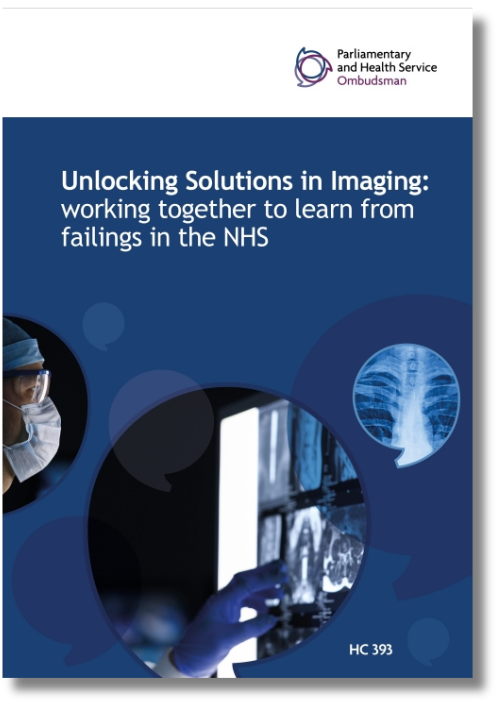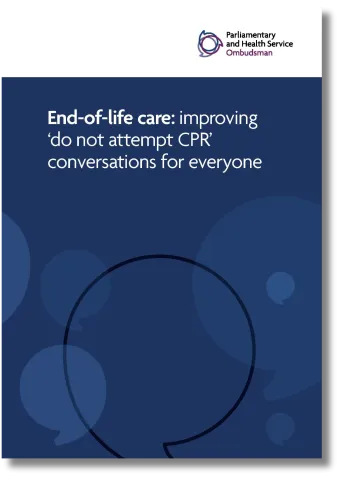Welcome to the second edition of Prioritising patient safety, our quarterly blog series.
Each month, we publish between 70 to 100 of our casework decisions as a way to share learning that will help organisations improve their service and prevent mistakes happening again. In this blog, we explore how findings from our casework can help colleagues across the NHS harness the power of complaints.
In this edition, I’ll focus on:
- how we are working with NHS England to improve NHS imaging services
- cases showing how organisations are making complaints count by listening, learning and putting things right
- important publications in the patient safety space.
Imaging: further positive engagement with the NHS

You may have seen media coverage of concerns we raised around imaging cases earlier this year. This followed up on our 2021 report, Unlocking Solutions and highlighted 45 cases we upheld or partly upheld in the years since.
We know this is a small proportion of the huge volume of imaging work that goes on across the NHS each year, but it is important for us to flag ongoing concerns where we see them.
In February’s edition of this blog, I shared the positive engagement we had with one particular Trust after we found it hadn’t taken appropriate steps to communicate unexpected findings on a scan. The Trust independently developed a detailed action plan to avoid this happening again.
We are pleased that this proactive and open engagement is reflected at national level too. In April we met with colleagues at NHS England (NHSE) who have national leadership responsibilities for imaging. They gave us a detailed update on actions they have taken to address concerns in our 2021 report.
This includes:
- A recently published paper developed with the Royal College of Radiologists to set out a ‘radiology lifecycle’. This defines what a standard workflow should look like for diagnostic imaging, from point of referral through to delivery of results. It aims to clarify the terminology used. This standardisation is critical to patient care, since it enables effective working between institutions or across networks.
- New guidance on how NHS trusts can automatically release verified imaging reports directly and digitally to patients. This should make it easier for patients to get their results. It will also serve as a backup should standard communication processes be delayed or missed. The guidance was developed by a range of NHSE teams working across imaging, diagnostics and the NHS App, with support from the Royal College of Radiologists, Society of Radiographers and patient representatives.
- Further guidance from the Royal College of Radiologists on ‘radiology events and learning meetings’ (REALMS) where inconsistencies and examples of excellence are anonymously reviewed for learning and reflection. Case studies of how these can be used effectively have now been circulated.
All this builds on the work of the group set up to respond to our recommendations and those in HSSIB’s investigation into follow-up of unexpected significant radiology findings. We welcomed this proactive approach at the time and are pleased to see work is ongoing.
These new developments are important steps to improving the imaging process for patients. We will keep colleagues at NHSE posted on any changing patterns in complaints that come to us as these new pieces of guidance bed-in and become part of frontline practice.
Working with a Trust’s Patient Safety Specialist to improve palliative care training

Last year, we published a report calling for urgent improvements to the process and communication surrounding do not attempt cardiopulmonary resuscitation (DNACPR). Since then, we’ve continued to receive a number of complaints related to end-of-life care, advance care planning and DNACPR orders.
Andrew’s story
One case involved Andrew, who was admitted to an Accident and Emergency (A&E) Department with symptoms including a persistent cough, shortness of breath, and confusion. A chest X-ray and CT scan showed a mass in his lung. Further scans revealed lesions on his brain, which the Trust initially believed to be an infection rather than cancer. Based on these findings, Andrew was discharged.
However, his condition worsened. He visited his GP with fatigue and a loss of appetite. Despite normal test results for infection, he developed Bell’s palsy (a temporary weakness affecting one side of his face) along with difficulty swallowing and being unable to close his eye or mouth.
Andrew was readmitted to hospital for further investigations. While the lung mass remained unchanged, an MRI showed a reduction in the size of the brain lesions. Further tests ruled out an infection.
As his health declined, Andrew was discharged home with Marie Curie and district nurses providing palliative care, as requested by his family. He passed away at home a few days later.
Andrew’s daughter complained that the Trust should not have brought her father back into hospital. She said that if the family had been told about his condition they would have cared for him at home.
The Trust responded by explaining it had investigated the cause of Andrew’s symptoms and explored treatment options during his hospital stay. It apologised for the family’s experience and said the treating doctor had communicated with Andrew and his family to the best of her ability.
Putting things right
After investigating, we concluded the communication and care provided were of an acceptable standard. However, the Trust acknowledged improvements could have been made in its palliative care, even though this would not have changed the outcome in Andrew’s case.
We worked closely with the Trust’s Patient Safety Specialist to improve palliative care provision. The Trust has now introduced several key initiatives including:
- mandatory e-learning on providing care and support for dying patients for both Registered General Nurses (RGNs) and Health Care Assistants (HCAs)
- face-to-face training in end-of-life care, delivered by the Palliative Care Team to both RGNs and HCAs
- ‘A Call 4 Concern’ system which is advertised throughout the ward and helps relatives or next of kin directly contact the team if they are worried about a patient's condition.
We’ll continue to work with colleagues across NHS England, Compassion in Dying and the Department of Health and Social Care to identify end-of-life care improvements.
Investigating delays in access to care
We receive many complaints about delays in access to care and treatment. This can include ambulance delays, Emergency Department (ED) delays, delays in administration of medication and delays to surgery.
One recent complaint we investigated involved all of these concerns.
Robert contacted us about the care and treatment his wife Sarah received from the NHS at several points. This started with a call for an ambulance after Sarah was experiencing severe abdominal pain. Robert called the ambulance three times before one arrived almost an hour later.
When Sarah arrived at the hospital she was in considerable pain. Robert was concerned that his wife did not receive adequate pain relief while she was in the ED and was left in pain. She was then transferred to a surgical ward.
Robert also raised concerns about the length of time his wife waited for surgery once on the ward and the number of staff on hand to provide appropriate care and treatment.
Putting things right
We investigated this complaint and were able to provide Robert with assurance that the ambulance service had acted appropriately. However, the service did acknowledge the impact of the delays. They also took steps to identify how additional staff training could prevent similar situations happening in the future. We found the delay did not have a negative impact on Sarah’s care.
In making our decision, we sought advice from two of our experienced clinical advisers. All our advisers are currently employed by the NHS and provide independent advice to inform our investigations, but the final decision lies with the investigator. In this case the adviser was able to address Robert’s concerns about the clinical treatment his wife received.
Although the outcome did not fully meet Robert’s expectations, we were able to reassure him that his complaint had been thoroughly and independently investigated by PHSO.
This case reflects themes seen in Health Services Safety Investigations Body’s (HSSIB) report on ambulance delays, underlining the importance of learning from complaints to improve future care.
What’s new in the world of patient safety
- “Patients with vision or hearing loss frequently encounter difficulties accessing vital health information, medication instructions, and effectively using medical devices.” - Henrietta Hughes, Patient Safety Commissioner.
- In March the Patient Safety Commissioner published The Safety Gap, a report on the safety and accessibility of medicine for people with sensory impairments or require accessible communication formats such as BSL.
- HSSIB have published two reports looking into how working conditions in the NHS can be optimised to support patient safety. One of these reflects on the impact of staff fatigue on patient safety.
- NHS England has published a new framework to tackle patient safety healthcare inequalities
In case you missed it
I recently appeared on PHSO’s podcast Making Complaints Count to discuss the launch of Prioritising Patient Safety and:
- how my work at PHSO informs my work as a GP
- the biggest patient safety challenges facing the NHS and how these can be overcome
- what culture changes are needed to improve patient safety
- how the NHS Complaint Standards can drive improvements.
Tony is a GP with over 30 years' experience in the NHS. He still works in clinical practice alongside his role at PHSO. Tony has been at PHSO for 10 years, initially starting as a clinical adviser to now leading the clinical advice function for the Ombudsman. You can follow Tony on LinkedIn.

